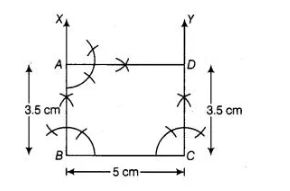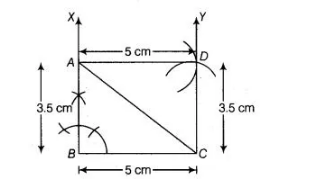Question:
Construct a rectangle whose adjacent sides are of lengths 5 cm and 3.5 cm.
Solution:
We know that, each angle of a rectangle is right angle (i.e., 90°) and its opposite sides are equal and parallel.
To construct a rectangle whose adjacent sides are of lengths 5 cm and 3.5 cm, use the 1 following steps
- Draw a line segment BC of length 5 cm.
- Now, generate an angle of 90° at points B and C of the line segment BC and plot the parallel lines BX and CY at these points.

- Cut AB and CD of length 3.5 cm from BX and CY, respectively.
- Draw an angle 90° at one of the point A or D and join both points by a line segment AD of length 5 cm.
Thus, ABCD is the required rectangle with
adjacent sides of length 5 cm and 3.5 cm.
Alternate Method
To construct a rectangle ABCD whose adjacent sides are of lengths 5 cm and 3.5 cm, use the following steps
1. Draw a line segment $S C$ of length $5 \mathrm{~cm}$.
2. Now, draw an $\angle X B C=90^{\circ}$ at point $B$ of line segment $S C$.
3. Cut a line segment $A B=3.5 \mathrm{~cm}$ from the ray $B X$ and join $A C$.

- Now, from A, point D is at a distance of 5 cm. So, having A as centre draw an arc of radius 5 cm.
- From C, point D is at a distance of 3.5 cm. So, having C as centre draw an arc of radius 3.5 cm which intersect previous arc (obtained in step iv) at D.
- Join AD and CD.
Thus, ABCD is the required rectangle with adjacent sides of length 5 cm and 3.5 cm.
